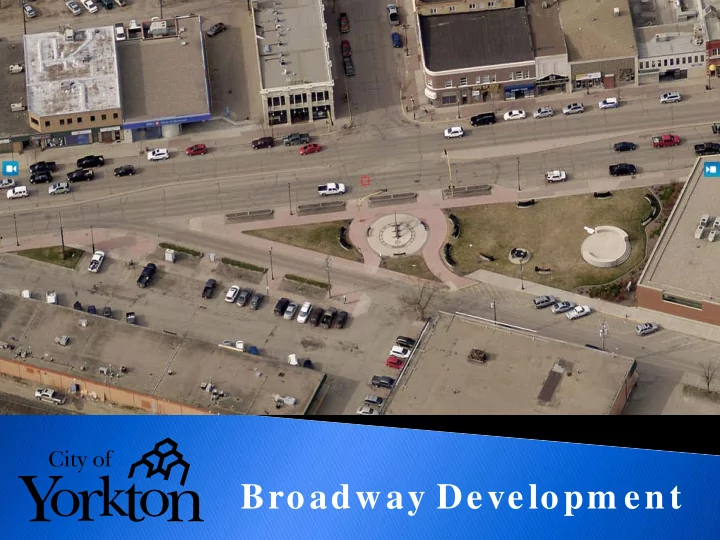

Broadway Developm ent
“There is little that is more disturbing to the public than to see a significant Public Works project in progress, and to observe the reinstatement of the pavement surface only to have the entire street dug up again for an entirely different purpose a short time later.” Federation of Canadian Municipalities – Best Practices
Infrastructure is installed at different times Infrastructure has different lifecycles. (Pavement 15 years versus water pipes 75 years) Components managed by different divisions or entirely different organizations Different sources of funding It is extremely important for the various infrastructure renewal programs to be coordinated to the maximum extent possible!!
Inventory of all infrastructure related assets Condition assessments of all the various types of municipal infrastructure Prioritize information collected from condition assessment (worst condition, most critical, highest number of users, etc.) Develop multi-year plans for infrastructure replacement Identify growth areas in the City and future development projects Designing infrastructure to accommodate future development
Project Scope (Highway 9 to Highway 10): Water distribution system Storm sewer system Sanitary sewer system Roadways Sidewalks Traffic lights
Water Main 8” to 12” pipe (200-300 mm) Mostly cast iron Large amount of 1909 to 1914 piping Lots of lead services remain Water main breaks increasing in the last ten years Sanitary Sewer Mains Primarily 12” pipe (300 mm) Pipes made of clay Large amount of 1909 to 1914 piping
Alexandra Avenue
Near Alexandra Avenue
Exhibition Street to Alexandra Avenue
Storm Sewer Mains Primarily 12” to 24” (200 mm to 400 mm) pipe Pipe material is mostly concrete Most of the piping is 1950 and newer, however some of the pipe is from 1915. Root infiltration in many areas Catch basins and leads are in poor condition
Sanitary sewer along Broadway Street
Broadway Street sanitary sewer from Clark Avenue to Bradbrooke Avenue
Broadway Street sanitary sewer Clark Avenue to Broadway Avenue
Aging Infrastructure (~100 years old): Increased O& M costs Insufficient capacity due to community growth: Restriction of future growth New regulations and industry standards: Non-Compliance with regulators
Integrated Engineering ◦ Derek Trischuk ◦ Darren Anholt
Questions & Answers
Financial restriction prevented large-scale reconstruction. Condition of underground infrastructure was unknown, as condition assessments had not yet been conducted. Lack of infrastructure master plans. Upgrades required to accommodate development were not properly identified.
The street will be reconstructed on a block-by-block basis. The arrangement upon which the excavation will be carried out will evaluate on the same basis. Many factors will influence the process used. These include street width, location of underground infrastructure and other underground utilities, type of equipment used by the contractor and even weather conditions. Every effort will be made to ensure traffic flow is maintained as efficiently as possible.
As part of the engineering planning process, traffic accommodation and business access will be reviewed in detail with discussion involving business members and stakeholders. Every effort will be made to reasonably minimize the amount of disruption to the downtown business community. However, will not compensate for financial losses.
Past BCF grant intakes for the City of Yorkton have been for 66% of the total project cost: • 33.3% Federal • 33.3%, Provincial • with City responsible for the remaining 33.3% The City anticipates grant-funding distribution will remain the same for this application; however, details have not yet been released.
The project would be tendered in 2015. The proposed timeline to rebuild the entire length of Broadway is three years.
If the project does not receive federal or provincial funding, the project will be delayed. Future grant opportunities would be pursued upon their release. The project would remain a priority for the City and would be proposed as a future capital project, however, a multi-year phasing approach would have to be explored due to financial constraints. Roadway resurfacing could take place without replacing underground infrastructure subject future underground failures and replacements. This is not a recommended option as it is a less efficient use of funds.
Regardless of the method of funding for the project, the City’s contribution required will be substantial. As part of the City’s long range planning, longer-term borrowing options will be explored.
Water and sewer services will be upsized to accommodate future changes in zoning, building code requirements and for fire suppression purposes. At this time service connections have been included in the total project cost estimate, however, cost sharing or how the service connections will be paid for has not yet been determined.
All City owned trees along Broadway would be evaluated based on age and health. Where possible healthy trees will be retained. It may be difficult to preserve trees; especially those located above water and sewer connections. During any reconstruction project it is sometimes difficult to work around trees without jeopardizing the critical root zone. New trees would replace those that are removed. Locations would be better planned to avoid future disturbances.
The proposed preliminary design maintains existing ROWs. The City has no intent of widening the existing ROW.
Recommend
More recommend